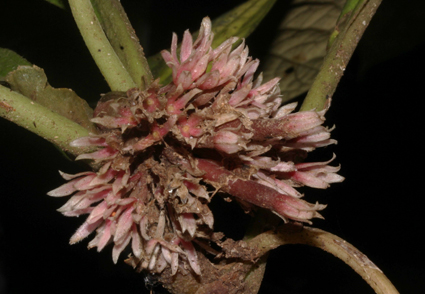Abstract
A floristic excursion in Zamboanga del Sur, Philippines led to the rediscovery of Acranthera philippinensis, an endemic Rubiaceous taxon with very limited information since 1905. This study provided a detailed description, a color plate, a distribution map of A. philippinensis, and information on its habitat and phenology. Based on the IUCN guidelines, A. philippinensis is provisionally categorized as Endangered (EN). In addition, a lectotype is also designated for this name. The findings of this study demonstrate the urgent need for more botanical research to be conducted in the Philippines, where numerous species await recollection and discovery.
References
<p align="justify"><span style="color: #000000;"><span style="font-family: Times New Roman, serif;"><span style="font-size: small;">Arnott, G.A.W. (1838) <em>Acranthera </em>Arn ex Meisn. <em>In: </em>Meisner, C.D.F. (Ed.) <em>Plantarun Vascularium Genera</em>. Libraria Weidmannia, Lipsiae, 115 pp.</span></span></span></p>
<p align="justify"><span style="color: #000000;"><span style="font-family: Times New Roman, serif;"><span style="font-size: small;">Bachman, S., Moat, J., Hill, A.W., de la Torre, J. & Scott, B. (2011) Supporting Red List threat assessments with GeoCAT: geospatial conservation assessment tool. <em>ZooKeys </em>150: 117–126. https://doi.org/10.3897/zookeys.150.2109</span></span></span></p>
<p align="justify"><span style="color: #000000;"><span style="font-family: Times New Roman, serif;"><span style="font-size: small;">Bremekamp, C.E.B. (1947) A monograph of the genus <em>Acranthera </em>Arn. ex Meisn. <em>Journal of the Arnold Arboretum </em>28: 261–308. https://doi.org/10.5962/p.185578</span></span></span></p>
<p align="justify"><span style="color: #000000;"><span style="font-family: Times New Roman, serif;"><span style="font-size: small;">Chen, T. & Taylor, C.M. (2011) <em>Acranthera </em>Arnott ex Meisner. <em>In: </em>Wu, Z.Y., Raven, P.H. & Hong, D.Y. (eds.) <em>Flora of China.</em> Vol. 19. Science Press, Missouri Botanical Garden Press.</span></span></span></p>
<p align="justify"><span style="color: #000000;"><span style="font-family: Times New Roman, serif;"><span style="font-size: small;">IUCN Standards and Petitions Subcommittee. (2022) Guidelines for using the IUCN Red List Categories and Criteria. Version 15.1 Prepared by the Standards and Petitions Committee. Available from: https://nc.iucnredlist.org/redlist/content/attachment_files/RedListGuidelines.pdf (accessed 9 November 2022).</span></span></span></p>
<p align="justify"><span style="color: #000000;"><span style="font-family: Times New Roman, serif;"><span style="font-size: small;">Korthals, P.W. (1851) Overzigt der Rubiaceën van de Nederlandsch-oostindische kolonien. <em>Nederlandsch kruidkundig archief</em> 2: 1–112.</span></span></span></p>
<p align="justify"><span style="color: #000000;"><span style="font-family: Times New Roman, serif;"><span style="font-size: small;">Merrill, E. (1913) Studies on Philippine Rubiaceae, I. <em>Philippine Journal of Science</em> 8: 1–32.</span></span></span></p>
<p align="justify"><span style="color: #000000;"><span style="font-family: Times New Roman, serif;"><span style="font-size: small;">Pelser, P.B., Barcelona, J.F. & Nickrent, D.L. (2011 onwards) Co’s Digital Flora of the Philippines. Available from: www.philippineplants.org (accessed 15 November 2021).</span></span></span></p>
<p align="justify"><span style="color: #000000;"><span style="font-family: Times New Roman, serif;"><span style="font-size: small;">Plants of the World Online (2022). Royal Botanic Gardens, Kew. Available from: http:// www.plantsoftheworldonline.org (accessed 20 November 2022). </span></span></span></p>
<p align="justify"><span style="color: #000000;"><span style="font-family: Times New Roman, serif;"><span style="font-size: small;">Puff, C., Igersheim, A., Buchner, R. & Rohrhofer, U. (1995) The united stamens of Rubiaceae. Morphology, anatomy; their role in pollination ecology. <em>Annals of the Missouri Botanical Garden</em>: 357–382. https://doi.org/10.2307/2399888</span></span></span></p>
<p align="justify"><span style="color: #000000;"><span style="font-family: Times New Roman, serif;"><span style="font-size: small;">Quantum GIS Development Team. (2016) Quantum GIS Geographic Information System. Open Source Geospatial Foundation Project. Available from: http://qgis.osgeo.org (accessed 25 November 2021).</span></span></span></p>
<p align="justify"><span style="color: #000000;"><span style="font-family: Times New Roman, serif;"><span style="font-size: small;">Rydin, C., Kainulainen, K., Razafimandimbison, S.G., Smedmark, J.E.E. & Bremer, B. (2009) Deep divergences in the coffee family and the systematic position of <em>Acranthera</em>. <em>Plant Systematics and Evolution </em>278 (10): 101–123. https://doi.org/10.1007/s00606-008-0138-4</span></span></span></p>
<p align="justify"><span style="color: #000000;"><span style="font-family: Times New Roman, serif;"><span style="font-size: small;">Tan, Y., Yang, B., Li, J., Zhou, S., Lone, S., Khaing, K.K., Li, R., Huang, J. & Sun, H. (2015) <em>Acranthera burmanica</em>, a new species of Rubiaceae from Kachin State, Myanmar. <em>Phytotaxa </em>238 (1): 92–96. https://doi.org/10.11646/phytotaxa.238.1.5</span></span></span></p>
<p align="justify"><span style="color: #000000;"><span style="font-family: Times New Roman, serif;"><span style="font-size: small;">Turland, N.J., Wiersema, J.H., Barrie, F.R., Greuter, W., Hawksworth, D.L., Herendeen, P.S., Knapp, S., Kusber, W-H., Li, D-Z., Marhold, K., May, T.W., McNeill, J., Monro, A.M., Prado, J., Price, M.J. & Smith, G.F. (2018) <em>International Code of Nomenclature for algae, fungi, and plants (Shenzhen Code) adopted by the Nineteenth International Botanical Congress Shenzhen, China, July 2017.</em> Regnum Vegetabile 159. Koeltz Botanical Books, Glashütten. https://doi.org/10.12705/Code.2018</span></span></span></p>


